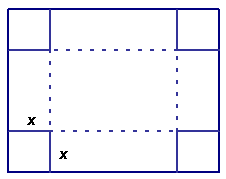This problem is a classic problem
in optimization from Calculus (with a couple new twists). Consider a rectangular
piece of cardboard that is 98 cm long and 76
cm wide. You create an open box by cutting square corners (x
cm by x cm)
from each of the four corners and bending up the sides. This study examines
how the volume and surface area of this open box varies as you vary the size
of the four corners that you cut out. (Give all answers to 4 significant
figures.)
a. Write a function for the volume
V(x)
of your open box depending on the size x
of the square corners that you cut out. What is the domain of this function
(from practical physical constraints)? Graph V(x)
on its domain, then find the maximum volume and how large a corner you must
cut to create this volume.
b. Write a function for the surface
area S(x) of your open box depending
on the size x of the square corners that
you cut out. Give the domain and range of this function. Graph S(x).
Is this function only increasing or decreasing (monotonic)?
c. We would like to plot the volume as a function
of the surface area without first solving one of these equations for x.
If you have placed Parts a. and b. on a single spreadsheet in Excel, then
you should be able to plot V (vertical
axis) vs S. Find the value of S
when V is maximum.

